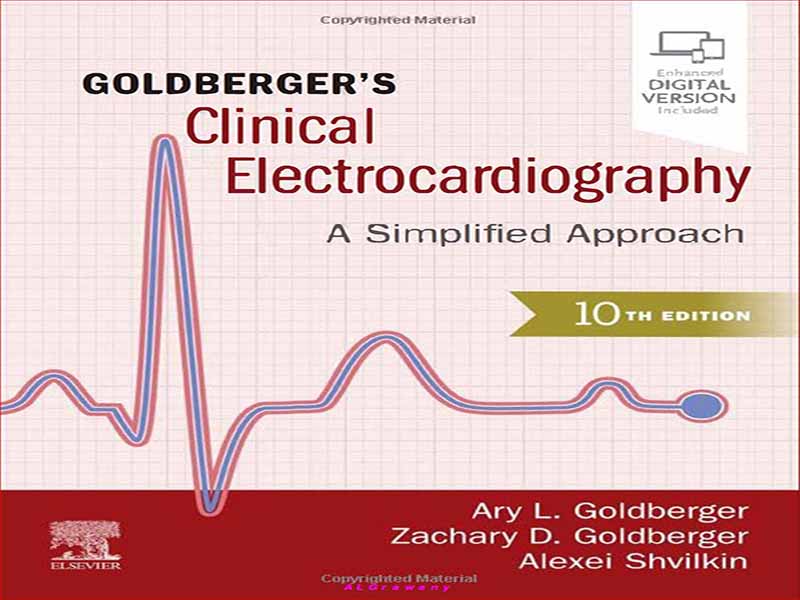- عنوان کتاب: Goldberger’s Clinical Electrocardiography
- نویسنده: Ary L. Goldberger
- حوزه: الکتروکاردیوگرافی
- سال انتشار: 2024
- تعداد صفحه: 385
- زبان اصلی: انگلیسی
- نوع فایل: pdf
- حجم فایل: 46.7 مگابایت
این کتاب مقدمه ای بر الکتروکاردیوگرافی است که مخصوص دانشجویان پزشکی، افسران خانه و پرستاران نوشته شده است. این متن، که هیچ دستورالعمل قبلی در خواندن نوار قلب (ECG) را فرض نمیکند، به طور گسترده در دورههای ابتدایی استفاده شده است. پزشکان خط مقدم، از جمله پزشکان فوریتهای پزشکی، بیمارستانها، تکنسینهای فوریتهای پزشکی، دستیاران پزشک و کارآموزان قلب و عروق که مایل به بررسی موارد ضروری هستند، با نسخههای قبلی مشورت کردهاند. درجه بالایی از “سواد” ECG برای کسانی که در مراقبت های بالینی حاد در تمام سطوح درگیر هستند، به طور فزاینده ای مهم است، و نیاز به دانشی دارد که بسیار فراتر از تشخیص الگوی ساده و کمک های یادگاری است. تفسیر ECG نه تنها به عنوان نقطه کانونی پزشکی بالینی بلکه به عنوان نمونه ای از تفکر انتقادی مهم است. دقت مورد نیاز شایستگی در تجزیه و تحلیل ECG، نیازمند توجه هم به ظریف ترین جزئیات و هم به قوس های فرعی استدلال یکپارچه است: «دیدن درختان و جنگل». علاوه بر این، تجزیه و تحلیل ECG یکی از آن حوزههای منحصربهفرد در پزشکی بالینی است که در آن به معنای واقعی کلمه دینامیک فیزیولوژیک و پاتوفیزیولوژیک را در چند ثانیه تا میلیثانیه مشاهده میکنید. نه به ندرت، تصمیمات آتش سریع کنار تخت بر اساس داده های ECG زمان واقعی است. دنباله حروف الفبای P-QRS-T-U، بسیار بیشتر از یک نمودار مسطح، یک نقشه برداری پویا از سیگنال های الکتریکی چند بعدی را نشان می دهد که به معنای واقعی کلمه در حال انفجار (خودکار) و پخش در سراسر قلب (رسانایی) به عنوان بخشی از فرآیندهای اساسی فعال سازی و بازیابی هستند. ECG برخی از قانعکنندهترین و جذابترین ارتباطات را بین علوم پایه «پیشبالینی» و تشخیص و درمان مشکلات بالقوه تهدیدکننده زندگی در محیطهای سرپایی و بستری فراهم میکند. این ویرایش جدید و دهم از قالب کلی نسخه قبلی پیروی می کند. مطالب به سه بخش تقسیم می شود. بخش اول اصول اولیه الکتروکاردیوگرافی 12 لید، الگوهای طبیعی ECG، و الگوهای دپلاریزاسیون غیرطبیعی عمده (QRS) و رپلاریزاسیون (ST-T-U) را پوشش می دهد. بخش دوم مکانیسم ریتم های سینوسی را شرح می دهد و به دنبال آن آریتمی های اصلی و ناهنجاری های هدایت مرتبط با تاکی کاردی ها و برادی کاردی ها را مورد بحث قرار می دهد. بخش سوم مطالب تخصصی تری از جمله مرگ ناگهانی قلبی، پیس میکرها و دفیبریلاتورهای قلبی قابل کاشت (ICDs) را ارائه می کند، و همچنین موضوعات منتخب “خیمه ای” ارائه شده از دیدگاه های مختلف (مانند سمیت دیجیتال، ایست قلبی ناگهانی) را برای افزودن ابعاد به آن مرور می کند. ارائه های قبلی ما مواد اضافی را برای بررسی و کاوش بیشتر در مکمل های آنلاین (ExpertConsult.com) در دسترس قرار می دهیم.
This book is an introduction to electrocardiography written especially for medical students, house officers, and nurses. The text, which assumes no previous instruction in reading electrocardiograms (ECGs), has been widely used in entry-level courses. Frontline clinicians, including emergency medicine physicians, hospitalists, emergency medical technicians, physician assistants, and cardiology trainees wishing to review the essentials have consulted previous editions. A high degree of ECG “literacy” is increasingly important for those involved in acute clinical care at all levels, requiring knowledge that far exceeds simple pattern recognition and mnemonic aids. ECG interpretation is important not only as a focal point of clinical medicine but as an exemplar of critical thinking. The rigor demanded by competency in ECG analysis requires attention both to the subtlest of details and to the subtending arcs of integrative reasoning: of “seeing the trees and the forest.” Furthermore, ECG analysis is one of those unique areas in clinical medicine where you literally observe physiologic and pathophysiologic dynamics “play out” over seconds down to milliseconds. Not infrequently, bedside rapid-fire decisions are based on real-time ECG data. The alphabetic P-QRS-T-U sequence, much more than a flat graph, represents a dynamic mapping of multidimensional electrical signals literally exploding into existence (automaticity) and spreading throughout the heart (conduction) as part of the fundamental processes of activation and recovery. The ECG provides some of the most compelling and fascinating connections between basic “preclinical” sciences and the recognition and treatment of potentially life-threatening problems in outpatient and inpatient settings. This new, tenth edition follows the general format of the previous one. The material is divided into three sections. Part I covers the basic principles of 12-lead electrocardiography, normal ECG patterns, and the major abnormal depolarization (QRS) and repolarization (ST-T-U) patterns. Part II describes the mechanism of sinus rhythms, followed by a discussion of the major arrhythmias and conduction abnormalities associated with tachycardias and bradycardias. Part III presents more specialized material, including sudden cardiac death, pacemakers, and implantable cardioverter-defibrillators (ICDs), and it also reviews selected “marquee” topics presented from different perspectives (e.g., digitalis toxicity, sudden cardiac arrest) to add dimensionality to the earlier presentations. We make additional materials for review and further exploration available in online supplements (ExpertConsult.com).
این کتاب را میتوانید بصورت رایگان از لینک زیر دانلود نمایید.




































نظرات کاربران